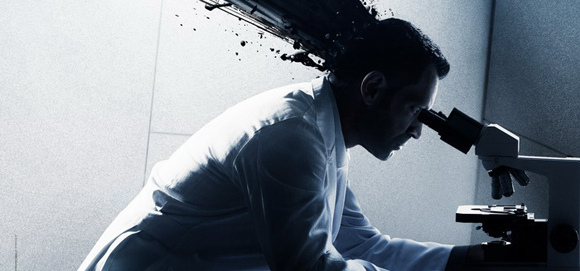My love of Battlestar Galactica is somewhat new, but it’s intense enough that I was very much looking forward to Syfy’s Helix, the new show by BSG creator Ron Moore. In it killer robots have been swapped out for a killer mystery disease, and instead of outer space we get a research facility in the Arctic. And hey, all things equal I’ll always prefer killer robots to everything else (except maybe robots with personality issues), but that doesn’t mean I couldn’t get over Helix‘s obscene lack of robots and have a rip-roaring good time when I watched its two-episode season premiere on Friday.
I didn’t.
My problem with Helix isn’t its lack of robots—I’m of the view that every show should have robots, from sci-fi epics to fantasies to historical teen dramas on the CW, and since most of them don’t I’ve pretty much gotten used to that inevitable disappointment. It’s not even the show’s premise, that a mysterious lab with a loose view of scientific safety standards has created an ultra-dangerous super-disease that it’s up to a team from the CDC to contain. I’m down with plagues. I’m down with ~secret government-sponsored experiments~. I’m particularly down for a sci-fi horror show taking place in a contained, isolated setting.
What I’m not down with is Helix‘s characters, specifically how they’re all ripped straight from TVTropes. Our main character is Dr. Alan Farragut (Billy Campbell), a square-jawed, stoic, senior CDC scientist whose difficulty maintaining a work-life balance resulted in a failed marriage before the show started. He’s also white, naturally, ’cause you’ve gotta tick off all the boxes on your boring, white bread hero Bingo card. Dr. Farragut’s ex-wife Julia (Kyra Zagorsky), another CDC bigwig, is on the team, as is his protégé Sarah (Jordan Hayes), who at one point proudly proclaims herself to be the youngest person every accepted to the something-something program at MIT. I’d have caught it but I was too busy rolling my eyes. She also has a crush on Farragut, by the way. The only female team member not in some way defined by their relationship to the strapping hero is animal expert Doreen, whom I’d like a hell of a lot more if she weren’t the cookie-cutter “quirky” team member. You have the CDC crew coming up against some requisite friction when the scientists at the lab refuse to cooperate with quarantine procedure and demand to be evacuated, despite the fact that they’re freaking scientists and therefore shouldn’t need Farragut to step in and give a speech about why quarantines are a good thing to have when there’s an infection winging its way around.
There’s also Dr. Hiroshi Hatake (Hiroyuki Sanada), the scientist in charge of the lab, and its military liason Major Balleseros (Mark Ghanimé), both of whom—and I bet you never saw this coming—are working for some undisclosed group to secretly create a weaponized plague. But Dr. Hatake has something else up his sleeve, as we see in the scene where his eyes are revealed to be an unnatural, glowy silver.
I have no problem with Hatake and Balleseros having ulterior motives—a show has to have its antagonists, after all, and if the foreboding-organization-working-on-a-dangerous-project-they-won’t-tell-anyone-about isn’t exactly original, well, neither are robots trying to wipe out humanity. (They could’ve used something besides black goo, though. C’mon, make it a different color.) Any plot can be handled well, and with the number of plot twists in BSG I wouldn’t presume to predict which direction Helix is heading in. Hataka looks like your stereotypical sneaky/evil scientist, with a calm demeanor masking utter creepiness that manifests itself most in an almost stalker-esque interest in Julia. And Balleseros looks like your stereotypical government henchman whose affiliation with the bad guys you’re surprised by because he just looked so sweet!
But both those characters could easily develop into something less typical and more interesting. So could the others. Doreen will likely evolve from one-note quirk. The base’s head of security, who’s also Hatake’s adopted son, could sidestep the boilerplate “conflict of interest” subplot that I can see lurking on the horizon after his surrogate father’s true motives start coming to the fore. Helix could step back from making Sarah moon after Farragut and give her an emotional arc that revolves around something other than unrequited love for the show’s lead. This is only the pilot, after all. The question, for me, is this: Do I want to stick around long enough to watch these walking clichés maybe develop into something more interesting? Do any of the characters give me enough now to keep me hooked?
The character of Julia is the best example of that. She was introduced as a BAMF scientist, but shortly thereafter a lot of her screentime was taken up by her relationship with three male characters. The first is Alan; despite Sarah (and therefore the audience) being reassured that he and Julia are adults who can keep it professional despite their history, over the course of the episode they cannot stop arguing about their personal issues. Maybe I’m still burned out on BSG’s Adama Drama, but I’m sick of it already. One of those issues is that Julia slept with Alan’s brother Peter, who just so happens to be Helix‘s Patient Zero. (The brothers’ relationship was subsequently strained, but Peter didn’t hate Alan so much that he didn’t warn him by using a special signal from their childhood in one of his video diaries. I’m sorry, but does something like that ever happen in real life?!) After the virus turns Peter into an ambulatory, super-strong, human-shaped plague he takes an interest in Julia that appears to go beyond the fact that he might still be holding a torch for her. The third character is Hatake, who keeps staring at her and keeps a scrapbook full of pictures of creeper pics.
So clearly something’s up with Julia. But how much by-the-book characterization can I make myself sit through before we get to what that is? That’s not even getting to my biggest problem with the pilot: The last scene, which saw Peter attacking Julia in the shower. It was previous established that Peter infects people by tackling them and putting his mouth on theirs, essentially breathing the disease into them. So when Peter comes after Julia when she’s naked in the shower, he’s not intending to sexually assault her. But that’s sure as hell what the writers of the show made it look like. It left a very, very bad taste in my life. The writers could easily have had that scene take place with Julia not naked, and it could’ve been just as scary. Do not use sexual assault, or the threat of sexual assault, for shock value, for the love of God.
So that’s what I thought about Helix. Barring a barrage of rapturous comments in the future saying how good the show’s gotten, I don’t think I’m going to keep watching. How about you?
Are you following The Mary Sue on Twitter, Facebook, Tumblr, Pinterest, & Google +?









Published: Jan 13, 2014 12:30 pm